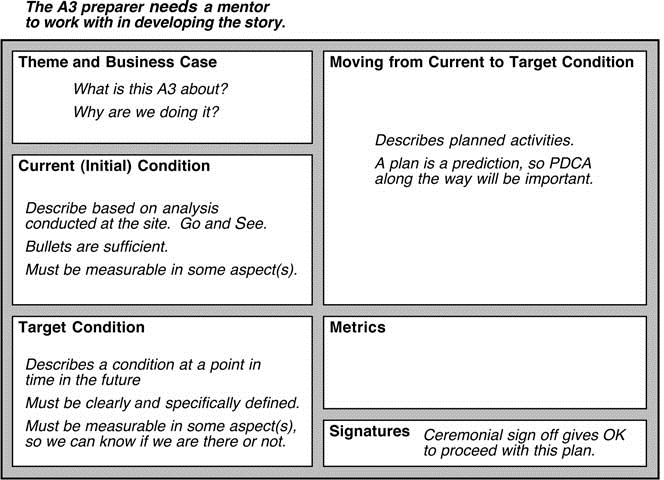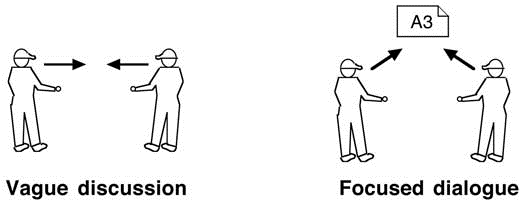Cycles of coaching should ideally be frequent, short, and conducted face-to-face. In the case example, Tina and Dan’s communication was all verbal. However, it is often advisable to use a simple, one-page written document in support of mentor/mentee coaching. Verbal communication alone can rely too little on data, and during verbal communication a mentee may naturally, and unconsciously, adapt what he is saying to what he thinks the mentor wants to hear.
By asking the mentee to summarize information in writing on one page in advance of coaching, the mentor can more clearly see how the mentee is approaching an issue and how she is thinking. This in turn helps the mentor see the next step and what coaching is required at this time. Limiting the document to one page compels the mentee to be clear in describing her analysis and proposal.
Typical items in mentor/mentee dialogue that make it onto a written document include:
- Summary of observations or current condition
- Target condition
- Proposals
- Plans
- Key points from reflections
At Toyota such one-page documents are called A3s because they are often made on a sheet of ledger-sized paper, referred to as A3-size in many countries.
The format of an A3 generally mirrors the steps of the improvement kata. They are written in a succinct, bulleted, and visual style that tells a story with data. Although the A3 is typically on one page, there can be additional pages of backup documentation. It is the “story” itself that is built up and presented on the single page.
The format of an A3 varies depending on the purpose and theme.
Figure 8-8 presents the typical sections of an A3.
You may notice that in this example A3, “Current Condition” comes before the “Target Condition,” which is a reversal of their order in the five questions at the end of Chapter 6. The reason for this is that the five questions come into play after a target condition has already been defined, whereas an A3 is from the beginning, where understanding the current condition precedes defining the target condition.
Each section of the A3 builds upon the previous one. The better you define the theme, the better you can assess the current condition. The better you assess the current condition, the better you can develop an appropriate target condition. And so on. As the mentee develops the A3, the mentor typically has the mentee focus on one section of the A3 at a time, and that section may be rewritten several times. That section is then the foundation for the next section.

Figure 8-8. Example of the A3 format
Purpose of an A3
The purpose of A3 documents is to support the mentor/mentee dialogue. This is done by:
- Having the mentee carefully think through something.
It is surprisingly difficult to distill our understanding about something down to one sheet of paper. Preparing a succinct and precise A3 forces you to develop a deep and clear understanding of a situation.

Figure 8-9. An A3 can help mentor/mentee interaction stay focused
I would have written a shorter letter, but I did not have the time.
—Attributed to Blaise Pascal, Johann Wolfgang von Goethe, and others
- Showing the mentor how the mentee is thinking, so the mentor can see what the next step is for the mentee, and what skills the mentee needs to develop.
- Keeping coaching focused and efficient (Figure 8-9). An A3 helps create a neutral, no-blame situation by giving both men- tor and mentee a focal point. If there is an important issue, question, or lesson learned, then it should be noted in the A3.
- Achieving consensus and clear action
- Providing milestones for process checks
Lessons Learned About A3s
This is another one of those instances where we can easily miss the point while trying to copy a Toyota practice. We tend to focus on the tool—the format of completed A3s that we see at Toyota—rather than on the less visible how and why an A3 is developed and used. Upon learning that Toyota utilizes A3s, some managers and consultants have singled them out as a lean tool and suggested that people use them. The result in many cases has been a lot of paper generation and not much more than that.
There is no magic in the A3 documents themselves. The trick is in how they are used, and here are some key points in that regard from our experimentation:
- An A3 is a tool that is used within and in support of the mentor/mentee dialogue, that is, the coaching kata, which in turn is being done to teach and drive application of the improvement kata. The improvement kata in turn is applied in pursuit of a long-term direction or vision, which exists because of an organization philosophy of improvement and An A3 by itself may not be so effective.
- An A3 is put together through a highly iterative, back-and-forth process between mentor and mentee. It is not just filled in at once and signed, because then it would just be a meaningless Imagine the document being slid back and forth between mentor and mentee several times as they develop a progressively better understanding of the current and target conditions, and step-by-step build up the sections of the A3. If there are not several push-backs, then the A3 document is not being used correctly.
Much of the benefit of an A3 lies in this process of creating it, because it forces you to work with facts and data and think through what you are doing. The objective and benefit is not so much to have a completed A3, but to go through the iterative, step-by-step process of developing it.
- It takes more time to develop a good A3 than you may think; sometimes weeks or even months.
- As already mentioned, in developing the A3, the mentor typically has the mentee focus on one section at a time, because each section of the A3 sets the framework for the You will probably go back and make adjustments often. Keep your eraser handy.
- Once the A3 is completed and signed it becomes a tool for making process checks as the mentee works toward the target condition. The A3 then becomes a tool to help mentor and mentee better identify problems along the way.
- A good way to start is to simply ask the mentee for a proposal on one blank sheet of paper, rather than predefining the A3 Wait and see what the mentee produces. Then you can discern how the mentee is thinking and guide him accordingly from there. This is like in the case example, when Tina started by giving Dan a vague assignment. She then waited for his response in order to see how he was thinking, before guiding him into the next step.
- Caution: a written document can encourage e-mail communication over face-to-face communication, or be used as a substitute for Go and Communication should remain face-to-face, and you should seek facts over data at the process.
- Talk less and communicate more, by staying focused on what is written in the Avoid ad-lib discussion, which is typically not based on facts and data, is quickly forgotten, and therefore wastes time. If there is no data, there is no basis for discussion. Have the mentee summarize the necessary points and data before coaching in order to help prevent this effect.
For more on the A3 process within mentor/mentee dialogues, see the book Managing to Learn, by John Shook.
Notes
- I use the word superior here, but as we will see, in many ways it is the mentor who is supporting the
- John Shook, Managing to Learn (Cambridge, Massachusetts: Lean Enterprise Institute, 2008), and https://www.lean.org